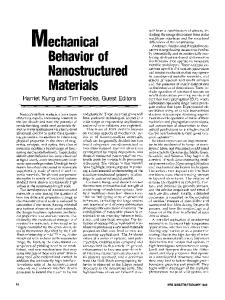Chemical Design of Nanostructured Luminescent Materials
- PDF / 120,453 Bytes
- 12 Pages / 595 x 842 pts (A4) Page_size
- 113 Downloads / 400 Views
Chemical Design of Nanostructured Luminescent Materials
Thierry Gacoin, Arnaud Huignard, Guillaume Counio, Jean-Pierre Boilot Groupe de Chimie du Solide, Laboratoire de Physique de la Matière Condensée, CNRS UMR 7643, École Polytechnique, 91128 Palaiseau Cedex, France.
ABSTRACT During the last 50 years, there has been a considerable amount of work for the elaboration of efficient luminescent materials, most of them dealing with the search for new chemical compositions. Only a very few studies have concerned the study of the influence of the microstructure of the materials on their properties of emission, especially when the grain sizes of the materials are in the nanometer range. On another side, important advances have been performed in colloid chemistry in the last years, especially in the case of II-VI chalcogenides, as a consequence on the intense activity around the physics of quantum confinement in semiconductors. The basic idea of this work is to show that the techniques developed in the case of II-VI nanoparticles could find interesting applications for the elaboration of nanostructured luminescent materials. This is first illustrated in the case of pure CdS nanoparticles, whose properties are deeply affected by their surface state and their chemical environment. Incorporation of manganese in solid solution in the CdS particles drastically changes the emission process, which now essentially depends on the manganese content inside each particle. Finally, the extension of the synthesis process to rare earth doped oxide particles is presented, and the luminescence efficiency is discussed as a function of the size, the structure, and the chemical environment of the particles.
INTRODUCTION Today, advanced technologies for the design of new devices such as flat panel displays require the optimization of the luminescent materials used for the production of light [1]. A tremendous amount of work has been made in this field for almost 50 years, mostly as industrial research, leading to the development of a large number of efficient materials [2,3]. The subject has now reached a point where any improvement can only be expected through the use of optimization techniques such as combinatorial chemistry [4]. In this context, no important breakthrough can be expected by searching for new chemical compositions. Besides their composition, luminescent materials are also characterized by their microstructure: grain size, surface state or interface with their host media and packing of the particles within the material. The optimization of the luminescence properties of phosphors, varying their microstructure is a subject which has certainly not been fully investigated yet. It is nevertheless clear that the penetration depth of the excitation energy, the influence of surface
CC9.5.1
Downloaded from https://www.cambridge.org/core. UNSW Library, on 18 Apr 2020 at 12:20:11, subject to the Cambridge Core terms of use, available at https://www.cambridge.org/core/terms. https://doi.org/10.1557/PROC-628-CC9.5
defects, the effici
Data Loading...











